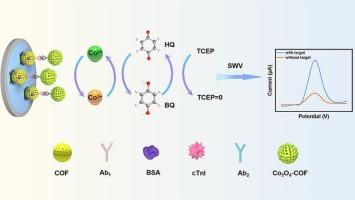通过cof约束的Co3O4实现级联氧化还原循环扩增,增强免疫感知。
IF 4.5
2区 化学
Q1 BIOCHEMISTRY & MOLECULAR BIOLOGY
引用次数: 0
摘要
本文以共价有机框架(COF)约束的Co3O4纳米颗粒(NPs)为信号探针,采用电化学-化学-化学(ECC)氧化还原循环扩增(RCA)策略提高灵敏度,研制了一种无酶、高效的三明治型cTnI检测电化学免疫传感器。具有高表面积和富氮的多功能COF不仅可以作为底物材料,还可以作为Co2+捕集的支架,使超细Co3O4 NPs受限生长和均匀分布成为信号放大平台,从而为ECC氧化还原循环反应提供丰富的催化活性位点。具有可变价态(Co3+/Co2+)的COF约束Co3O4 NPs作为氧化还原活性电极材料,可以显著增强电流信号。ECC的氧化还原循环由电极处的Co3+与电活性对苯二酚(HQ)的氧化还原反应触发,而HQ则由还原剂三(2-羧基乙基)膦(TCEP)再生,导致用于cTnI分析的电流信号显著放大。所构建的免疫传感器具有良好的性能,线性范围为1 ~ 100 ng mL-1,检出限低至0.88 fg mL-1。此外,该免疫传感器成功应用于人血清中cTnI的检测,证明了其临床应用潜力。本文章由计算机程序翻译,如有差异,请以英文原文为准。

Cascade redox cycling amplification enabled by COF-confined Co3O4 for enhanced immunosensing
Herein, an enzyme-free and highly efficient sandwich-type electrochemical immunosensor for cTnI detection was developed using covalent organic framework (COF) confined Co3O4 nanoparticles (NPs) as the signal probe and enhancing the sensitivity with electrochemical-chemical-chemical (ECC) redox cycle amplification (RCA) strategy. The multifunctional COF, with high surface area and rich nitrogen, serves not only as a substrate material but also as a scaffold for Co2+ entrapment, enabling the confined growth and uniform distribution of ultrafine Co3O4 NPs as signal amplification platform, thereby providing abundant catalytic active sites for ECC redox cycling reactions. COF confined Co3O4 NPs with variable valence states (Co3+/Co2+) serve as a redox-active electrode material that can enhance the current signal substantially. The ECC redox cycle is triggered by the redox reaction between Co3+ at the electrode and electroactive hydroquinone (HQ), while HQ was regenerated by the reducing agent tris (2-carboxyethyl) phosphine (TCEP), resulting in a significant amplification of the current signal for cTnI analysis. The constructed immunosensor exhibited excellent performance with a wide linear range from 1 fg mL−1 to 100 ng mL−1, and a low detection limit of 0.88 fg mL−1. Furthermore, the immunosensor successfully applied to detected cTnI in human serum, proving its clinical potential.
求助全文
通过发布文献求助,成功后即可免费获取论文全文。
去求助
来源期刊

Bioelectrochemistry
生物-电化学
CiteScore
9.10
自引率
6.00%
发文量
238
审稿时长
38 days
期刊介绍:
An International Journal Devoted to Electrochemical Aspects of Biology and Biological Aspects of Electrochemistry
Bioelectrochemistry is an international journal devoted to electrochemical principles in biology and biological aspects of electrochemistry. It publishes experimental and theoretical papers dealing with the electrochemical aspects of:
• Electrified interfaces (electric double layers, adsorption, electron transfer, protein electrochemistry, basic principles of biosensors, biosensor interfaces and bio-nanosensor design and construction.
• Electric and magnetic field effects (field-dependent processes, field interactions with molecules, intramolecular field effects, sensory systems for electric and magnetic fields, molecular and cellular mechanisms)
• Bioenergetics and signal transduction (energy conversion, photosynthetic and visual membranes)
• Biomembranes and model membranes (thermodynamics and mechanics, membrane transport, electroporation, fusion and insertion)
• Electrochemical applications in medicine and biotechnology (drug delivery and gene transfer to cells and tissues, iontophoresis, skin electroporation, injury and repair).
• Organization and use of arrays in-vitro and in-vivo, including as part of feedback control.
• Electrochemical interrogation of biofilms as generated by microorganisms and tissue reaction associated with medical implants.
 求助内容:
求助内容: 应助结果提醒方式:
应助结果提醒方式:


